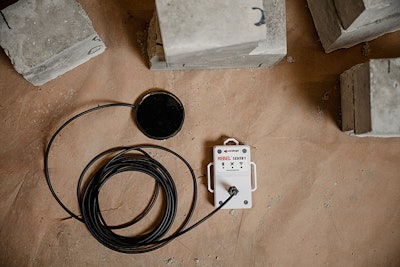Concrete Sensors to Strengthen Highways Closer to Adoption
An AASHTO committee has adopted a new standard for the Rebel Concrete Strength Sensors, which provide real-time data on poured...

Concrete strength sensors that have been in development since 2017 have just become a new national standard.
The American Association of State Highway and Transportation Officials’ Committee on Materials and Pavements has adopted a new standard for the Rebel Concrete Strength Sensors, which are embedded into fresh concrete and provide real-time data on its strength.
A news release from Purdue University, where the technology has been developed for the last seven years, says the sensors “may shorten construction timelines and increase long-term durability of concrete highways, bridges and other transportation infrastructure.”
These sensors are either secured to reinforcement or placed on the subgrade. After the concrete has been poured, cables protruding from each sensor are accessible to workers above the concrete’s formwork. From there, plugging the cables into a handheld device allows contractors to log data on the strength of the concrete.
The ability to more quickly know when concrete can bear the weight of heavy truck traffic means less downtime for the traveling public and a lowered chance of loading the concrete too soon and causing damage.
Purdue’s Reilly Professor in the Lyles School of Civil Engineering, Luna Lu, heads up the lab where the sensors were invented and founded Wavelogix in 2021 to market and manufacture them on a larger scale.
Wavelogix recently received a $3 million investment from Rhapsody Venture Partners and has secured a group of angel investors.
 These sensors are either secured to reinforcement or placed on the subgrade when used.Purdue University
These sensors are either secured to reinforcement or placed on the subgrade when used.Purdue University
“The majority of our infrastructure was built in the 1950s and 1960s. At that time, the population in the U.S. was only half of the current population,” said Lu. “This means that all this infrastructure was not built and designed for the volume of traffic, the frequency of use and the amount of people we have today. We have to think of a better way to communicate with our infrastructure.”
Beta testing is currently underway in 11 states across the Midwest, South and West, though the tech’s future depends on the results of those tests and incorporation of the method as a standard into state specifications, as well as interest from contractors.
“Every time I’ve handed a sensor to a contractor, the only question they’ve asked me is ‘When will this be available?’ The value added to the industry is so apparent to the people who would be using this technology on a day-to-day basis,” Lu said.

 machineryasia
machineryasia 





